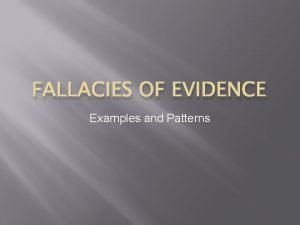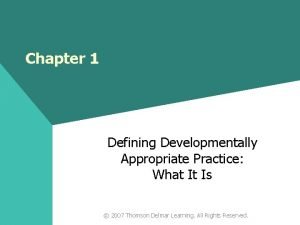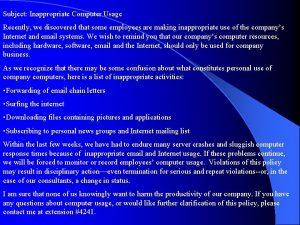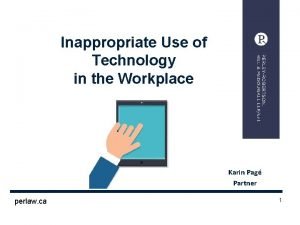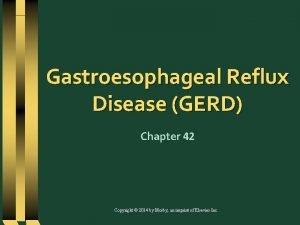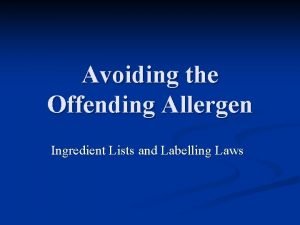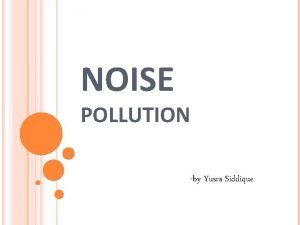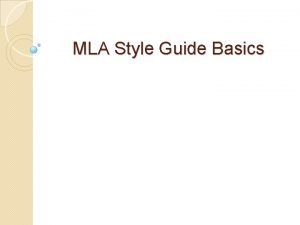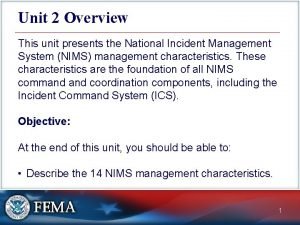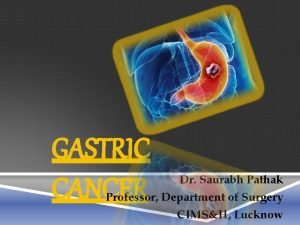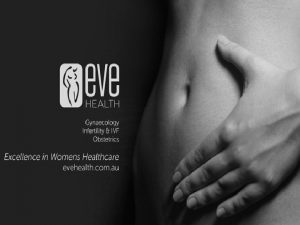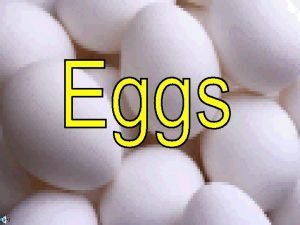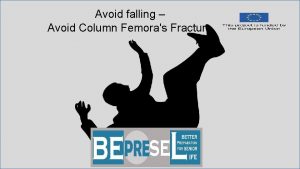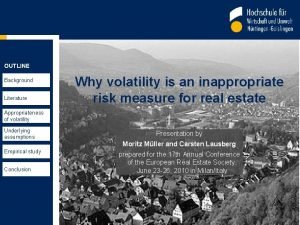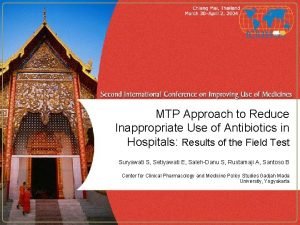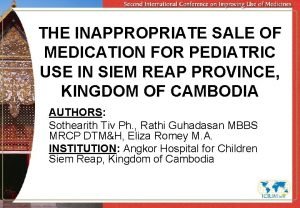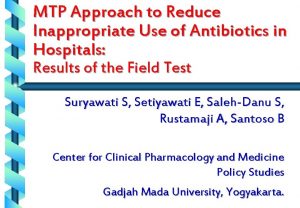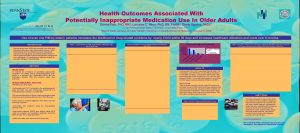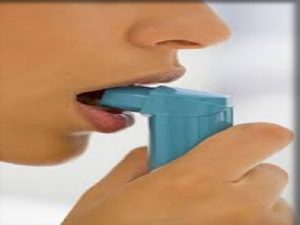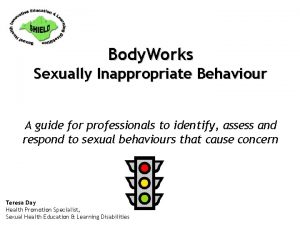13 8 24 1 How to avoid inappropriate




























- Slides: 28

13: 8: 24: 1

How to avoid inappropriate treatments on your infertile couples Dr Ben Kroon MBCh. B FRANZCOG CREI Director (Eve Health) Clinical Director (The Fertility Centre) Subspecialist in reproductive endocrinology and infertility (Queensland Fertility Group) Senior lecturer in O & G (UQ) 13: 8: 24: 2

Contents • The outcomes of IVF conceived offspring • What can the GP do to ensure the patient receives appropriate treatment? • • 13: 8: 24: 3 Referral at appropriate time Identify relevant pathology Maximise pre-conceptual health Be aware of non IVF treatments Support safe IVF Refer to appropriate specialist Refer to an appropriate unit

IVF: Offspring Outcomes • genetics • no increased risk of aneuploidy • increased risk with ICSI • epigenetics • • large offspring syndrome Angelmann Prader Willi Beckwith Wiedemann • congenital abnormalities • increased risk of congenital abnormalities 13: 8: 24: 4

IVF: Offspring Outcomes • singleton • preterm delivery • increased delivery < 32/40 (RR: 3. 27) • increased delivery < 37/40 (RR: 2. 04) • birth weight • increased delivery < 1500 g (RR: 3. 00) • increased delivery < 2500 g (RR: 1. 70) • SGA • increased SGA (RR: 1. 4) • C/Section • increased C/S (RR: 1. 54) • NICU • increased NICU admission (RR: 1. 27) • PNMR • increased PNMR (RR: 1. 68) 13: 8: 24: 5

IVF: Offspring Outcomes • multiple pregnancy • preterm delivery • no difference delivery < 32/40 • increased delivery < 37/40 (RR: 1. 07) – small increase • birth weight • no difference delivery < 1500 g • no difference delivery < 2500 g • SGA • no difference SGA • C/Section • increased C/S (RR: 1. 21) • NICU • increased NICU admission (RR: 1. 05) – small increase • PNMR • lower PNMR (RR: 0. 58) 13: 8: 24: 6

IVF: Offspring Outcomes • long term effects • • 13: 8: 24: 7 increased risk of consultation / admission increased psychomotor development increased height at puberty increased obesity increased heart disease increased cardiovascular disease increased infertility

Why else is IVF not always the most appropriate treatment? • • • Cost Stress Discomfort Time Maternal risks • Ovarian hyperstimulation syndrome (OHSS) • Surgical risks 13: 8: 24: 8

How can you help avoid inappropriate treatments for your infertile couples? 13: 8: 24: 9

Infertility • inability of a couple to fall pregnant over a period of twelve months of unprotected intercourse • 15 out of 100 couples will not have conceived at one year • 7 out of 100 couples will not have conceived at 2 years 13: 8: 24: 10

Provide a timely referral • > 35 yrs old – After 6 months unprotected intercourse • ≤ 35 yrs old – After 12 months unprotected intercourse • Earlier if there is a history of menstrual irregularity, prior PID, proven endometriosis, genetic concerns etc. • Always refer the partner • Beware the patient who has never used contraception but has only been trying for a short time 13: 8: 24: 11

Identify relevant pathology • FBC, Blood group and Abs, Hepatitis B/C, HIV, syphilis, Rubella, pelvic scan, semen analysis, pap smear - generally agreed upon • TSH, vitamin D, varicella, AMH – many perform • Karyotype, Thrombophilia screen, ANA, coeliac screen, urinary chlamydia and gonorrhoea PCR, genetic screening – some perform 13: 8: 24: 12

Recently released by Queensland Fertility Group Preconception screening for 590 recessive genetic disorders 13: 8: 24: 13

Identify relevant pathology – don’t forget the bloke Always check the semen analysis, even if there is another clear cause for infertility 13: 8: 24: 14

Identify potential pathology – is surgery a possibility? • If GP has identified that surgery is a possibility then the patient may be more likely to accept appropriate surgery • • Eg. dysmenorrhoea / pelvic pain menorrhagia Fibroids on scan PID • BUT – laparoscopy is definitely not always needed or appropriate 13: 8: 24: 15

Maximise patient health • Weight optimisation • Smoking cessation • Treatment of medical conditions eg. • • BP Diabetes Thyroid disorders Consider referral to general / obstetric physician • Folate 13: 8: 24: 16

Weight loss • BMI should be <35 prior to fertility treatment (RANZCOG guidelines) • • • Obesity and fertility - increased infertility, failed fertility treatment, miscarriage, foetal abnormalities, diabetes, hypertensive disorders, macrosomia, obstructed labour, shoulder dystocia, caesarean section, anaesthetic problems, Obstetric haemorrhage, perinatal morbidity / mortality……………. 13: 8: 24: 17

Smoking • Women - Increase in infertility OR 1. 60 (95% CI 1. 34 - 1. 91) and pregnancy complications • Almost double the number of IVF cycles needed to achieve a pregnancy • Men - Worsened semen parameters • Smoking cessation improves fertility outcomes 13: 8: 24: 18

Approaches other than IVF do work! • Environment - Lifestyle changes - Anti-oxidants • Surgery Male - Vasectomy reversal Female - Ovarian drilling - Endometriosis resection - Tubal corrective surgery - Fibroid removal (submucosal fibroids) • Assisted Reproductive technology (ART) - Ovulation induction / Superovulation - Intrauterine insemination • Other - Tubal flushing 13: 8: 24: 19

Treatments other than IVF - PCOS • First line • Clomiphene citrate • If clomiphene resistant add metformin • Consider metformin alone if anovulatory and BMI ≤ 30 kg/m 2 (equivalent preg and live birth rate) • Second line • FSH injections • Laparoscopic ovarian drilling (equivalent to FSH with decreased multiple pregnancy rate (1% vs 17%) • Consideration of bariatric surgery if BMI ≥ 35 kg/m 2 • Third line • IVF 13: 8: 24: 20

Treatments other than IVF – surgery for endometriosis • Minimal – mild disease Treatment improves fertility outcomes (Cochrane 2008) • Moderate – severe disease Treatment may improve outcomes (non-randomised trials) • Surgical treatment of endometriosis improves fertility outcomes 13: 8: 24: 21

TUBAL FLUSHING increases pregnancy rate (OR 3. 3, 95% CI 2. 0 – 5. 43) increases live birth rates (OR 2. 98, 95%CI 1. 4 – 6. 37) 13: 8: 24: 22

Supporting safe IVF practices may help minimise inappropriate treatments in your patients • Lower dose stimulation – aim for 8 -12 oocytes • Antagonist protocols – (approx. 50% reduction in OHSS) • Agonist triggers • Freeze all embryos • Minimise unproven treatments eg. steroids • SINGLE EMBRYO TRANSFER 13: 8: 24: 23

Avoiding inappropriate treatment • ASSIST IN HELPING PATIENTS KNOW WHEN ENOUGH IS ENOUGH 13: 8: 24

Refer to the appropriate specialist • College accredited subspecialists in reproductive endocrinology and infertility (CREI) • 3 years full time training • Exit examinations • Publications • Other formal qualifications – Masters of reproductive medicine – 1 yr part time • Generalists with a special interest 13: 8: 24: 25

Referral to the appropriate unit • IVF only units • Vs • Full service fertility providers • • • 13: 8: 24: 26 Individualised management Ovulation induction Insemination Donor services Preimplanation genetic diagnosis etc.

Summary • IVF is an excellent treatment, but is not always the most appropriate treatment • Avoidance of inappropriate treatments may be assisted by • • 13: 8: 24: 27 Timely referral Identification of relevant pathology Maximising pre-conceptual health Supporting non IVF treatments Supporting safe IVF Referral to appropriate specialist Referral to an appropriate unit

13: 8: 24: 28
 Pictures of inappropriate dress at work
Pictures of inappropriate dress at work Inappropriate evidence example
Inappropriate evidence example Developmentally appropriate practice
Developmentally appropriate practice Narrow qrs complex
Narrow qrs complex Inappropriate computer use
Inappropriate computer use Imperativo
Imperativo Inappropriate behavior
Inappropriate behavior Inappropriate use of technology in the workplace
Inappropriate use of technology in the workplace 3 inappropriate dress items for fbla
3 inappropriate dress items for fbla What is security through obscurity and why is it bad
What is security through obscurity and why is it bad Rule of thirds
Rule of thirds Which type of plan shows the layout of hvac system
Which type of plan shows the layout of hvac system Avoid barricade confront
Avoid barricade confront Pathophysiology of hiatal hernia
Pathophysiology of hiatal hernia The target person complies in order to obtain
The target person complies in order to obtain What is a source qualifier in speech
What is a source qualifier in speech Avoid the offending allergen that
Avoid the offending allergen that Intrapersonal communication barriers
Intrapersonal communication barriers Dysmotility foods to avoid
Dysmotility foods to avoid What key factors contribute to safe driving on freeways
What key factors contribute to safe driving on freeways If you can't avoid it enjoy it
If you can't avoid it enjoy it Avoid extremes
Avoid extremes Avoid the obvious content
Avoid the obvious content Yusra siddique
Yusra siddique Needed to avoid plagiarism
Needed to avoid plagiarism Which nims management characteristics includes developing
Which nims management characteristics includes developing A child has learned to avoid a furry black cat
A child has learned to avoid a furry black cat Prey adaptations to avoid predators
Prey adaptations to avoid predators D1 d2 d3 gastrectomy
D1 d2 d3 gastrectomy

